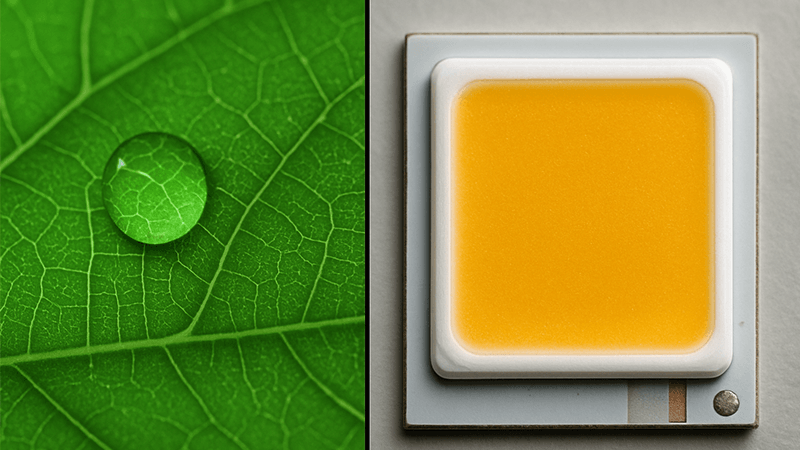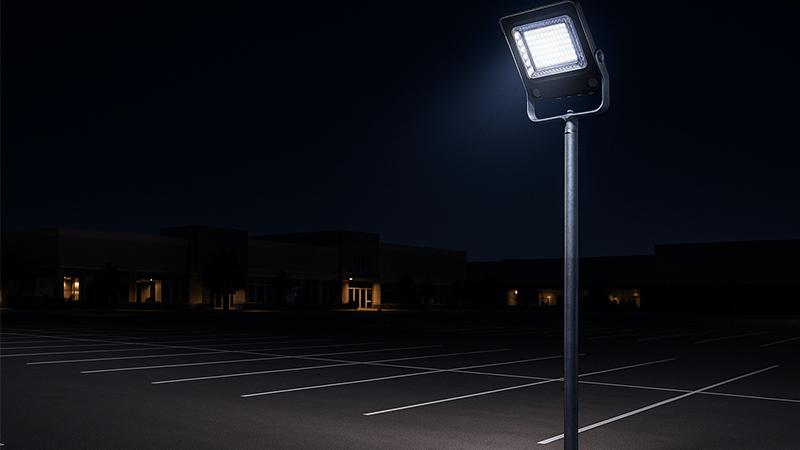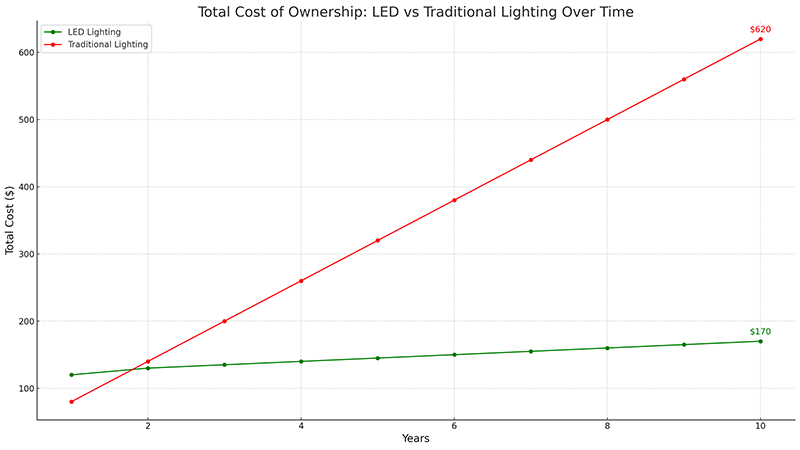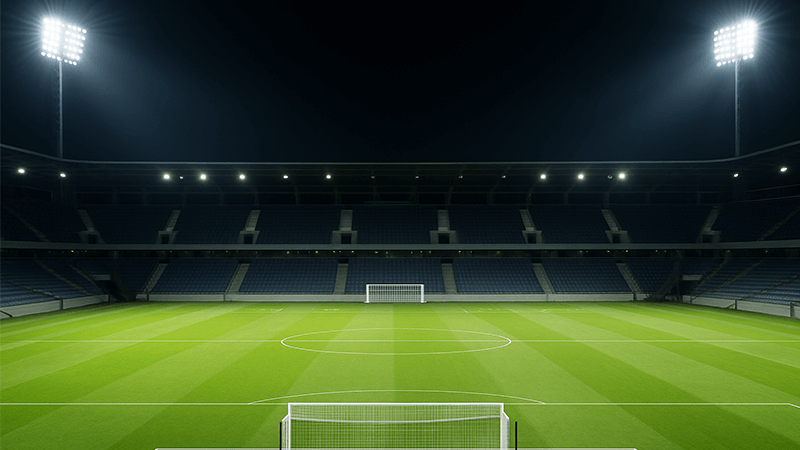Tired of high energy bills and constant maintenance from old floodlights? This eats into your budget and hurts your project’s environmental goals, creating unnecessary waste and costs.
The most significant environmental benefit of LED floodlights is their efficiency and longevity. They use up to 80% less energy than traditional lights and last over 25 times longer. This drastically cuts carbon emissions, reduces landfill waste, and eliminates hazardous materials like mercury from the environment.

For over a decade in the lighting industry, I’ve seen technology evolve firsthand. The shift from traditional lighting to LEDs wasn’t just an upgrade; it was a revolution, especially for the environment. Early on, my clients were focused purely on brightness. Now, customers like you are asking deeper questions about sustainability and long-term impact. The good news is that what’s best for the planet is now also best for your bottom line. Let’s break down exactly how making the switch to LED floodlights creates a positive environmental impact, starting with the biggest questions my partners ask.
How does LED lighting affect the environment?
You want to make sustainable choices, but it is hard to see the full environmental impact of different lighting technologies. This makes it difficult to justify your decisions confidently.
LEDs have a profoundly positive effect on the environment. They significantly reduce energy consumption, which lowers carbon emissions from power plants. They also contain no mercury, eliminating toxic waste. Plus, their directional light minimizes light pollution, protecting nocturnal ecosystems and preserving dark skies for everyone.

When we talk about environmental impact, we have to look at the entire life of a product, from creation to disposal. Based on my experience manufacturing these products, LEDs win at every stage. The biggest and most immediate impact is the reduction in energy use. A traditional 1000W metal halide floodlight can be replaced by a 300W LED floodlight that produces the same amount of light. That’s over a 70% reduction in energy consumption for just one light. Now imagine that saving scaled across a stadium, a port, or an entire city. This directly translates to fewer greenhouse gas emissions.
Another critical factor is the material composition. Older technologies like fluorescent and high-pressure sodium lamps contain mercury, a toxic heavy metal that is hazardous to dispose of. LEDs are solid-state devices and are completely mercury-free. This simplifies disposal and eliminates the risk of environmental contamination.
Finally, let’s consider their lifespan. A long-lasting product is an environmentally friendly product. Fewer replacements mean less manufacturing, less packaging, less shipping, and less waste in landfills. A typical LED floodlight can last 50,000 hours or more, while a metal halide might only last 6,000 to 15,000 hours. The reduction in waste is substantial.
| Environmental Factor |
Traditional Lighting (MH/HPS) |
LED Lighting |
| Energy Consumption |
High (e.g., 1000W) |
Very Low (e.g., 300W for same output) |
| Carbon Footprint |
Large |
Small (up to 80% reduction) |
| Hazardous Materials |
Contains Mercury & Lead |
None (Mercury-free) |
| Lifespan |
Short (6,000-24,000 hrs) |
Very Long (50,000+ hrs) |
| Light Pollution |
High (Omni-directional light) |
Low (Directional light) |
What are the advantages and applications of LEDs compared to traditional light sources?
Your projects demand reliability, but traditional floodlights often fail. They are fragile, need constant bulb changes, and take time to warm up, which costs you in maintenance and performance.
LEDs offer superior lifespan, energy efficiency, and unmatched durability. They are perfect for applications like sports fields, parking lots, and architectural lighting where performance and low maintenance are essential. Their solid-state design and instant-on capability also boost security and operational efficiency.

From a manufacturing standpoint, I can tell you that the advantages of LEDs are built-in from the ground up. Unlike glass bulbs with fragile filaments, LEDs are solid-state devices. This makes them incredibly resistant to shock, vibrations, and impact. For projects in high-traffic areas or industrial zones, this durability is a game-changer. It means fewer failures and a safer environment.
A key advantage we focus on at our factory is resilience to outdoor conditions. In places like the UAE, intense sun can degrade materials quickly. This is why we use special anti-aging surface treatments on our floodlight housings. An anti-UV powder coating protects the fixture, ensuring it does not fade, crack, or corrode over years of exposure. This maintains both the light’s performance and its appearance, protecting your investment. This is a detail I learned was critical after seeing fixtures from other companies fail in just a few years.
This durability, combined with design flexibility, opens up countless applications. Because LEDs are small, we can create fixtures with precise optics that shape light and direct it exactly where it’s needed. This is ideal for everything from grazing a building’s facade with light to illuminating a massive shipping port without causing glare for operators.
| Feature |
Traditional Lighting (MH/HPS) |
LED Lighting |
| Efficiency (lm/W) |
60-100 lm/W |
130-180+ lm/W |
| Lifespan |
Shorter |
5-10x Longer |
| Durability |
Fragile (glass, filaments) |
Very Robust (solid-state) |
| Warm-up Time |
5-15 minutes |
Instant On |
| Control |
Limited (On/Off) |
Full (Dimming, Smart Controls) |
| Common Applications |
Older streetlights, warehouses |
Stadiums, Airports, Architectural, Ports |
Why are LED lights better than traditional lights?
You need to justify your purchasing decisions to stakeholders with clear, bottom-line benefits. It can be hard to translate technical specs into a simple, powerful argument for making a change.
LEDs are better because they deliver a significantly lower total cost of ownership. The initial purchase price is quickly offset by massive savings in energy and zero maintenance costs. They also produce far superior light quality, improving visibility, safety, and aesthetics for any project.

As a purchasing manager, you are always evaluating the total cost of ownership (TCO). This is where LEDs truly outshine everything else. I often walk clients through this calculation. While the upfront cost of an LED fixture might be higher than a traditional one, the financial story completely changes over time. Let’s break it down.
First, the energy savings are immediate and ongoing. A project that replaces 100 traditional 1000W floodlights with 300W LED equivalents will save 70,000 watts of power every hour they are on. Over a year, this translates into tens of thousands of dollars in electricity savings alone.
Second, consider maintenance. Traditional lamps require regular bulb replacements. This involves buying new bulbs and paying for the labor and equipment (like a lift truck) to install them. With a lifespan of 50,000 hours or more, an LED floodlight can operate for over a decade without any maintenance. For hard-to-reach fixtures on high poles or building tops, this alone can justify the switch.
Finally, there is light quality. Traditional sources like high-pressure sodium lamps have a very low Color Rendering Index (CRI), making everything appear yellowish and washed out. LEDs offer a high CRI, rendering colors accurately. For a retail space, this makes products look better. For a parking lot or industrial area, it means security cameras can capture clear, accurate video, and workers can better identify hazards, which dramatically improves safety.
| Cost Factor (5-Year TCO Example) |
1000W Metal Halide |
300W LED Floodlight |
| Initial Cost |
Lower |
Higher |
| Energy Cost |
High |
~70% Lower |
| Re-lamping Cost |
High (2-3 replacements) |
Zero |
| Maintenance Labor |
High (Requires labor/lifts) |
Zero |
| Total Cost Over 5 Years |
Very High |
Significantly Lower |
What are the benefits of using LED lighting in large spaces?
Lighting large spaces like ports, airports, or sports fields is a huge challenge. Gaps in illumination create unsafe dark spots, while poorly aimed lights cause glare and waste massive amounts of energy.
For large spaces, LEDs deliver powerful, uniform light without dark spots. Their precise optical control focuses light only where needed, cutting energy waste and light spill. This precision enhances safety, improves operational visibility, and provides a better experience for everyone.

I remember working on a project for a large shipping terminal. Their old high-mast lighting created pools of bright light and large areas of deep shadow. It was inefficient and, more importantly, unsafe for the staff working at night. This is a common problem that LED technology is uniquely positioned to solve. The benefits for large spaces come down to three key areas: control, uniformity, and safety.
Unmatched Light Control
Traditional floodlights are omni-directional; they spray light everywhere. We then use large, inefficient reflectors to try to aim it. LEDs are naturally directional. We use small, advanced lenses for each LED chip to shape the light with incredible precision. For a large area, this means we can design a lighting plan that sends light to the exact spots required, building up layers of light to create a perfectly uniform field. This eliminates waste and light trespass into neighboring properties.
Enhanced Safety and Security
In a large industrial space or airport apron, visibility is safety. The high-quality, high-CRI light from LEDs allows workers to see clearly, read labels, and identify potential hazards. The light also helps security personnel and cameras. A well-lit perimeter is a strong deterrent, and clear camera footage is essential for incident reviews. The instant-on nature of LEDs means they can be integrated with motion sensors for an immediate security response, something impossible with the warm-up time of metal halide lamps.
Extreme Durability for Demanding Environments
Large outdoor spaces are exposed to the elements. The fixtures need to withstand heat, rain, wind, and even corrosive salt spray in coastal areas. This is where robust construction is non-negotiable. Our floodlights are built with durable die-cast aluminum housings and impact-resistant polycarbonate lenses. Combined with the anti-UV and anti-corrosion surface treatments I mentioned earlier, these fixtures are designed to perform reliably for years in the toughest environments, ensuring the space remains safe and operational.
Conclusion
Ultimately, switching to LED floodlights is a smart business decision. It dramatically lowers your environmental impact, reduces long-term operational costs, and delivers superior lighting quality and safety for any project.